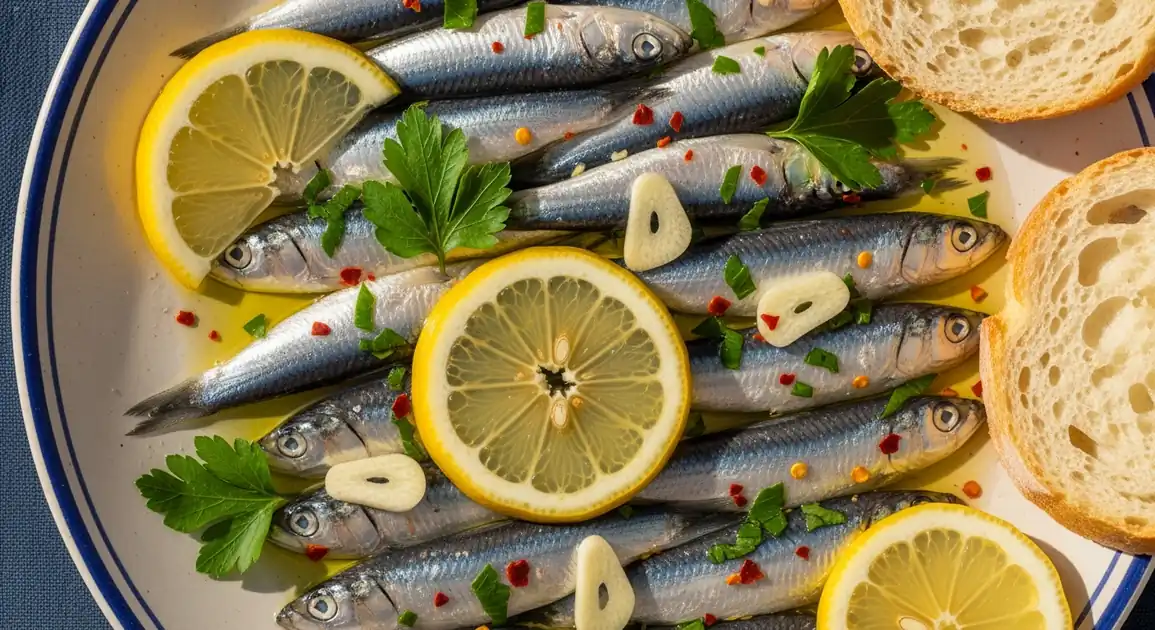Marinated Anchovies
Alici Marinate

Description
Alici Marinate is primarily associated with southern Italy, especially the coastal regions of Campania. While you can find this dish throughout Italy, it's most authentic in areas with access to extremely fresh anchovies. The preparation showcases Italy's culinary philosophy of highlighting excellent ingredients with minimal intervention.
Dietary Information
Serving information
Serving style
Typically served chilled as an antipasto on a small plate, often garnished with additional fresh herbs, lemon slices, and accompanied by crusty bread ('fresella' or 'friselle' in Campania). Usually eaten family-style as a shared appetizer.
Quick facts
Fish restaurants typically serve lunch 12 PM - 3 PM and dinner 7 PM - 10:30 PM. Markets are usually open 7 AM - 1 PM.
Safety Tips
What to Look For
-
Bright, silvery-white flesh with a firm texture
Properly marinated anchovies should have opaque, silvery-white flesh that holds its shape. Transparency indicates insufficient marination; mushiness suggests over-marination or poor quality fish.
-
Clear marinade with visible lemon slices and fresh herbs
The oil and lemon mixture should be transparent to slightly cloudy, never murky or excessively cloudy, with visible ingredients like lemon slices, parsley, and perhaps thin garlic slices.
-
Proper refrigeration at all times
Alici marinate should be kept consistently chilled in display cases. Never consume if left at room temperature for extended periods.
-
Made same day or previous day
For optimal safety and flavor, the preparation should be recent. Quality establishments prepare small batches daily.
What to avoid
-
Gray or yellowish coloration in the fish
Discoloration indicates spoilage or oxidation. Fresh, properly marinated anchovies should maintain their silvery-white appearance.
-
Strong ammonia or overly fishy smell
A pungent aroma suggests decomposition. The scent should be pleasantly oceanic with notes of lemon and herbs.
-
Slimy texture or falling-apart fish
Properly marinated fish should be tender but still hold its shape. A slimy texture or fish that's disintegrating suggests bacterial growth or excessive marination.
-
Pre-packaged versions with long shelf life
Industrial versions with preservatives lack the delicate flavor and texture of fresh preparations and may mask quality issues.
Price information
Price range
Budget tips
- Local trattorias away from tourist centers usually offer better value than upscale restaurants.
- Port areas and fish markets often have the freshest versions at reasonable prices.
- A standard portion (usually 8-12 pieces) is meant as an appetizer to share, not a main course.
Value indicators
- Visible freshness of the fish (bright, firm flesh).
- Generous amount of good quality olive oil.
- House-made daily rather than commercial preparations.
- Served with quality bread.
- Appropriate portion size relative to price.
Where to Find This Dish
Coastal Areas
Restaurants and trattorias along the coastline tend to have the freshest seafood preparations.
Harbor fronts, Fishing villages, Beach-adjacent dining areas
Lunch (12 PM - 2 PM), Early Dinner (7 PM - 8 PM)
Fish Markets
Many Italian fish markets have food stalls serving fresh preparations.
Local mercato del pesce, Indoor market halls
Morning (8 AM - 11 AM)
City Centers
Look for established traditional restaurants rather than obvious tourist traps.
Historic district trattorias, Family-run establishments
Lunch (12 PM - 2 PM), Dinner (7 PM - 10 PM)
Vendor Tips
- Ask when the fish was delivered or purchased from the market.
- Small plates with fewer, carefully prepared pieces often indicate better quality than large portions.
- Local wines by the glass usually pair well with regional seafood preparations.
How to Order
Regional Variations
-
Alici al Limone
(Alici al Limone)
A simplified version using only lemon juice, olive oil, and sometimes salt and pepper, highlighting the pure flavor of the fish and citrus.
-
Alici Marinate with Orange
(Alici Marinate all'Arancia)
A winter variation that uses orange juice instead of or alongside lemon, creating a slightly sweeter profile.
-
Spicy Marinated Anchovies
(Alici Marinate Piccanti)
Includes more significant amounts of red pepper flakes or fresh chili for a spicier version popular around the Calabria-Campania border.
-
Herb-Forward Variation
(Alici Marinate alle Erbe)
Incorporates additional Mediterranean herbs like mint, oregano, or wild fennel for a more aromatic profile.
-
White Wine Marinated Anchovies
(Alici Marinate al Vino Bianco)
Includes a splash of white wine in the marinade, often Falanghina or Fiano, adding complexity to the flavor profile.
Cultural context
History
This traditional preparation dates back centuries along Italy's Amalfi Coast and Bay of Naples, where fishermen would preserve the day's abundant catch of small blue fish. The acid-curing technique provided a practical preservation method before refrigeration, while the lemon groves of Sorrento and Amalfi supplied the perfect marinade component. The dish embodies the simplicity and freshness-focused approach of authentic Neapolitan cuisine.
Local significance
Represents the coastal Italian approach to food: simple preparations that highlight extremely fresh ingredients. Demonstrates the historical need to preserve abundant catches without refrigeration.
Eating customs
- Spread on bread to soak up the flavorful marinade.
- Eaten in small quantities as a flavor-opener for a meal.
- Often shared family-style along with other antipasti.